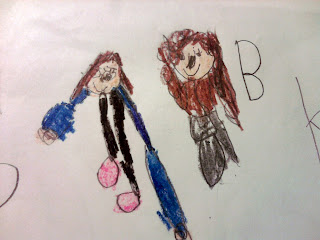Did you ever find yourself surrounded by magnetic letters and say, "I should know what to do with all of these?"
Well, that was me a few days ago. I found myself in one of my cupboards at school and before I knew it the cupboard was emptied all over my carpet and I discovered a scary reality. I had tubs upon tubs of magnetic letters with very little purpose. I did the logical thing, packed them up in a crate and put them in the back of my car. Ah, no longer a problem in my cupboard, but what was I going to do with them??

I have long been attempting to get really good with "word work." You know, get it all organized, have a bunch of awesome activities at my finger tips. Well, I can now happily say I am one activity closer. I spent my Monday evening finishing up what I started on Sunday, a magnetic letter sorting marathon. Isn't it beautiful? I even ended up with a huge tub of, "to donate" letters and some empty containers. Now my letters will be workin' for me!
On an additional note, here are the word work activities I have started this year as well as a small list of what I plan to get going soon. I started small and I really think that my word work skills are growing. I have also included a few sites that will likely overwhelm the "word work" newcomer, but they have really good ideas. Just tackle a few and get started!
I began by assigning a word work activity to each day of the week. Lately I have been doing two to three to differentiate for student needs. I hope to get to a point where more activities are open and students can choose their form of word work, take their word list, and get busy!
Here is my starter list:
Play dough words--Make snakes into letters or make a pancake and write on it with a pointy object--golf tee is one of the best ideas I have seen.
Watercolor Words--Write words with yellow or white crayon, wash over them with watercolor paint for a wax resist piece of word work art.
Connect Four--Fill an 8X8 or 16X16 grid with words students have learned. Taking turns with a partner, students read a word and cross it out, then color in a set of four when they "connect four."
Word Puzzles--Write letters of a word on small square pieces of card stock. Write the word on an envelope and place the squares inside. Students put the word together then write it down; I start with names.
Dry Erase or Chalk Boards (I also got some neat black dry erase boards this year for something different).
What I hope to start soon:

My new and improved word boxes! I have white boards that I have divided with tape into three columns. One column is for a word card--read the word, the second column is for making the word with letters, then the final column is a spot to write the word with a dry erase marker. I think my little word sort boxes will work nicely with those divided boards.
I also bought some pebble style fish gravel that I am going to have students use to do "pebble spelling." I have mats with the word already written down. Students can cover the letters with pebbles forming the word. I would like to get some other objects to use like shells or flat glass pebbles.
Here are some great website resources too!
















